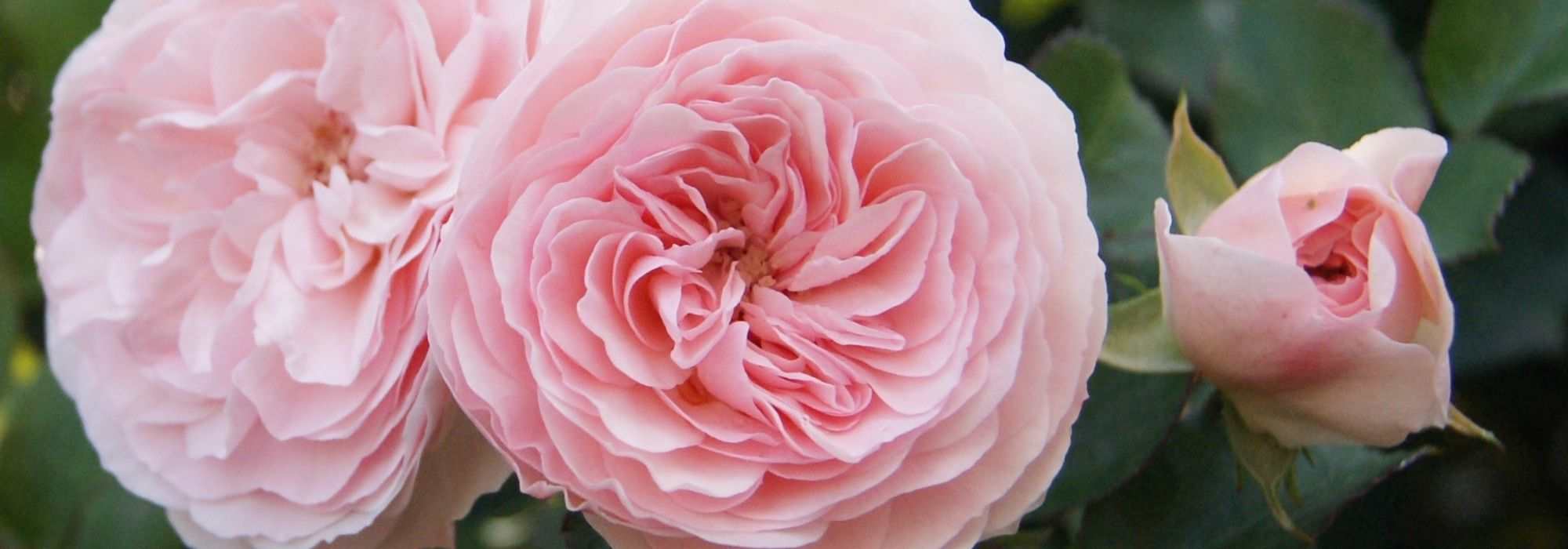
How to choose an English rose?
Buying guide and criteria for finding the ideal variety
Contents
The English roses from breeders David Austin or Robert Harkness are prized worldwide for their qualities and reliability in the garden. They combine the elegance and fragrance of old roses with all the health benefits of modern roses.
In addition to their undeniable aesthetic qualities, these roses also offer a long repeat flowering period, as well as great ease of cultivation, being resistant to diseases and cold.
Whether bush roses or climbing roses, they can be used throughout the garden.
Depending on their various characteristics (flower colour and shape, fragrance, size, and use…), find the perfect English rose for your garden.
Choosing an English rose based on flower colour
The colour palette of English roses is very diverse. For reliable choices, turn to the classic yet timeless red, pink, and white English roses. For an original touch, dare to choose orange, yellow, purple, or even multicoloured roses.
Pink English Roses
From pastel pink to deep pink with a hint of violet, pink English roses are rich in shades. They adapt to all styles of gardens, from the most classic to the most contemporary.
- For a pale or very soft candy pink, discover ‘Constance Spry’, ‘Heritage’, ‘Olivia Rose Austin’, or ‘Albrighton Rambler’.
- For a more intense pink, prefer ‘Eglantyne’, ‘James Galway’, ‘Gentle Hermione’, or ‘The Lady of the Lake’.
- For a bright, more intense pink, opt for ‘English Legend Sir Lancelot’, ‘Princess Alexandra of Kent’, ‘Royal Jubilee’, or ‘The Mayflower’.
- ‘Wild Edric’, ‘Young Lycidas’, and ‘Wild Edric’ produce flowers that are pink with violet or mauve tones.
- Other roses offer a warm pink tinged with salmon, orange, or peach, such as ‘A Shropshire Lad’, ‘Legend Oxford’, ‘Abraham Darby’, or ‘Boscobel’.
White English Roses
White roses are certainly the easiest to pair in the garden, their immaculate colour allowing them to be combined with both dark plants and those with light blooms. They bring lightness and brightness, with a true touch of refinement or romance.
Among them:
- the rose ‘Claire Austin’ with its beautiful pearly white flowers
- ‘Snow Goose’, with white flowers and a cream centre
- ‘Glamis Castle’, showcasing an ivory white
- ‘Tranquillity’ or ‘Winchester Cathedral’, with a delicate pure white
- ‘William and Catherine’, with roses of a white tinged with cream
- ‘Desdemona’, offering a rarer white with peach-pink reflections
- ‘Kew Gardens’, whose white petals are illuminated by a lemon yellow centre and a nest of stamens
Red English Roses
As great classics of the genre, red roses bring a lot of character to the garden, whether they are in classic or modern styles. Different shades of red, from the softest to the most intense, are available among English roses.
- ‘Docteur Watson’ displays a bright vermilion red,
- ‘Darcey Bussel’, ‘Falstaff’, and ‘LD Braithwaite’ prefer a crimson red
- ‘English Legend Hamlet’ offers a scarlet red with pink tones
- ‘Thomas à Becket’ reveals flowers of a light red turning carmine over time
- Less common, the red of ‘Benjamin Britten’ only reveals itself after passing through a salmon-pink and dark pink
 Rosa David Austin ‘Heritage’, ‘Tranquility’, and ‘Thomas à Becket'[/caption>
Rosa David Austin ‘Heritage’, ‘Tranquility’, and ‘Thomas à Becket'[/caption>
Yellow and Orange English Roses
Yellow and orange roses bring a lot of warmth. While they may seem more difficult to pair, they are perfect for a very bright monochrome.
When combined with complementary blue or purple plants, the balance will also be well achieved.
- On the yellow side, ‘Vanessa Bell’ and ‘Austin Imogen’ offer a very soft pale colour. ‘The Pilgrim’, ‘The Poet’s Wife’, and ‘Teasing Georgia’ have a more intense, energetic colour. Finally, some cultivars are adorned with a nuanced yellow, with warm golden or coppery reflections, such as ‘Golden Celebration’, ‘Austin Molineux’, or ‘Malvern Hills’.
- Among the orange English roses, we can mention the soft ‘The Lark Ascending’, ‘Roald Dahl’, and ‘The Lady Gardener’. For a brighter, more festive orange, opt for ‘Dame Judi Dench’, ‘Pat Austin’, ‘Summer Song’, or ‘Carolyn Knight’.
- ‘Lady Emma Hamilton’ offers an uncommon mandarin-orange colour, but yellow-orange on the reverse of the petals.
Other Less Common Colours
Less common, purple roses add a touch of mystery. ‘William Shakespeare’ allows its crimson red to evolve into a deep purple. On the other hand, ‘Munstead Wood’ offers us an intense velvety purple.
And for a true splash of colour, turn to the exuberant ‘The Alexandra Rose’, with its multicoloured eglantine flowers. They blend coppery pink and light pink, with a golden yellow and cream centre.
‘Fighting Temeraire’ also offers an explosion of colours in warm tones, with its orange, apricot, pink tones and golden yellow centre. A bit softer, ‘Morning Mist’ is adorned with a salmon-orange hue at its yellow centre, highlighted by red stamens.
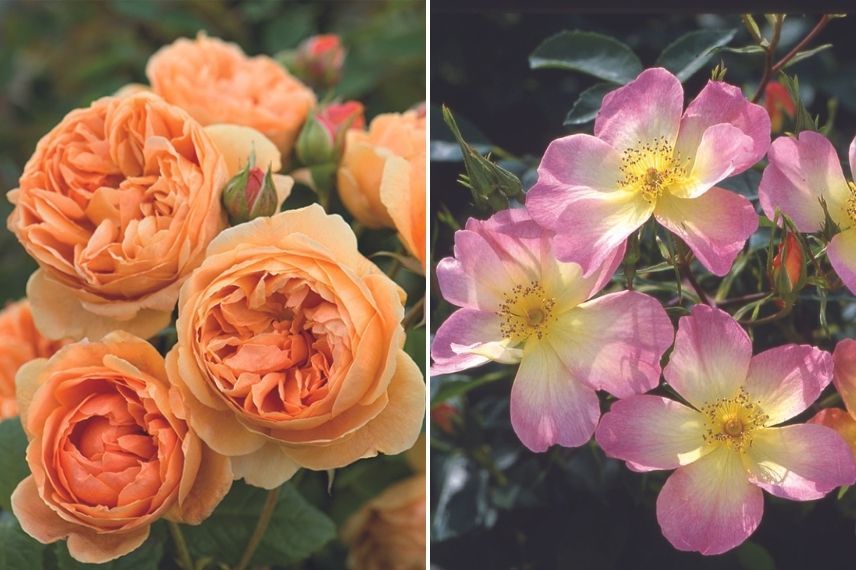 Rosa David Austin ‘Carolyn Knight’ and ‘The Alexandra Rose’
Rosa David Austin ‘Carolyn Knight’ and ‘The Alexandra Rose’
Choosing an English rose based on flower shape
English roses generally have fleshy, full, and round flowers, well double with many petals, like ‘Spirit of Freedom’ or ‘James L. Austin’.
They can resemble real pom-poms as seen in ‘English Legend Hamlet’, ‘Princess Anne’, and ‘The Mayflower’.
Others have a very refined cup shape, almost spherical, like ‘Royal Jubilee’, ‘Covent Garden’, and ‘Tranquillity’.

Rosa ‘Spirit of Freedom’ (photo Wang kun hung), Rosa ‘Princess Anne’ (photo Wikipedia) and Rosa ‘Royal Jubilee’
Some have a more tousled appearance, like ‘Snow Goose’ with its daisy-like roses.
Finally, some English roses have eglantine flowers with only a few petals, bringing a very fresh and natural touch to the garden. They reveal a nest of colourful stamens clearly visible in their centre. Among them, we find ‘The Alexandra Rose’ and ‘Morning Mist’, as well as the bright ‘Tottering-by-Gently’ and the delicate ‘Kew Gardens’.
In terms of size, the most impressive English roses display flowers over 10 cm in diameter. This is the case with ‘Ozeana’, ‘Rose de Cornouaille’, or ‘English Legend King Arthur’. The record goes to ‘William Shakespeare’ and ‘Jubilee Celebration’ with their flowers measuring 12 cm, as well as ‘Brother Cadfael’ whose large flowers can reach 14 cm.

Rosa ‘Snow Goose’, ‘Tottering-by-Gently’ and ‘Brother Cadfael’
Discover other David Austin Roses
View all →Available in 2 sizes
Available in 2 sizes
Available in 2 sizes
Available in 2 sizes
Available in 2 sizes
Available in 2 sizes
Available in 2 sizes
Available in 2 sizes
Available in 2 sizes
Choosing an English rose based on its fragrance
One of the strengths of English roses lies in their often powerful and rich fragrance. The scents are extremely varied and cater to all tastes. They can be fruity, sweet, woody, herbaceous, spicy, or floral.
Fragrances are often more pronounced in warm, calm weather.
Among the most fragrant or surprising varieties, we can mention:
- ‘Graham Thomas’, whose characteristic scent of yellow roses resembles that of tea roses, with hints of violet
- ‘Heritage’, revealing a fruity and sweet fragrance, combining notes of honey, carnation, and myrrh
- ‘The Poet’s Wife’, with a powerful lemon scent that becomes sweeter over time
- ‘English Legend Hyde Park’ with a fresh fragrance of nectarine and lemongrass
- ‘English Legend King Arthur’ featuring spicy notes of anise and cinnamon
- ‘William Morris’ with an astonishing tea rose fragrance that evokes banana
- ‘James L. Austin’, with its less intense but unusual scent of red fruits
- ‘Golden Celebration’, which has won awards for its fragrance blending tea, strawberry, and notes of sweet white wine
- ‘English Legend Sir Lancelot’, with fruity notes of peach and pear
- ‘Darcey Bussel’ with a fruity scent and hints of fresh grass
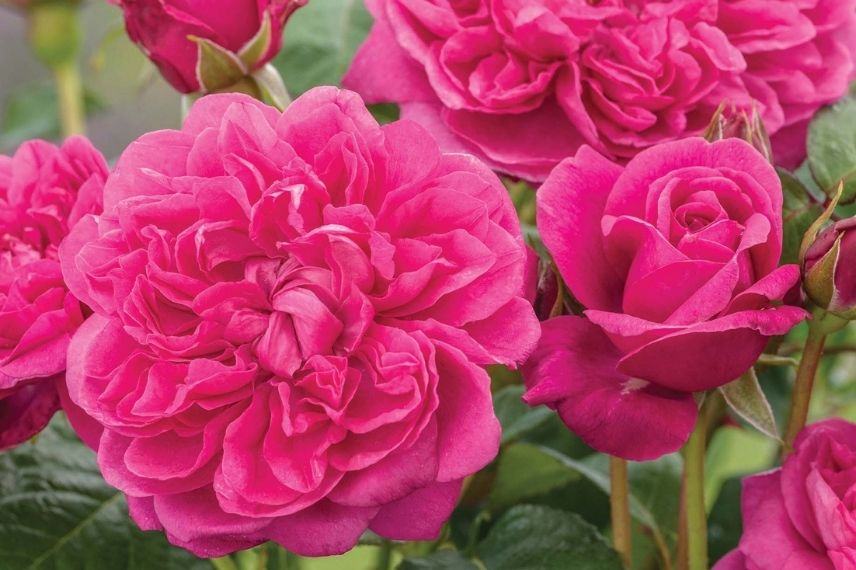
Rosa David Austin ‘James L. Austin’
Read also
English garden: 10 emblematic plantsChoosing an English rose based on the flowering period
English roses generally have an abundant flowering period that lasts all summer, from June to October, showcasing their beauty for nearly 5 months. The varieties are repeat flowering, meaning they bloom several times almost continuously. Flowering will be encouraged if faded blooms are regularly removed.
However, some cultivars are a bit earlier and can start flowering as soon as mid-spring, in May. ‘English Legend Sir Lancelot’, ‘Gertrude Jekyll’, ‘Mary Rose’, and ‘Olivia Rose Austin’ thus bloom in successive waves almost without interruption, from May until October, or even November depending on the climate.
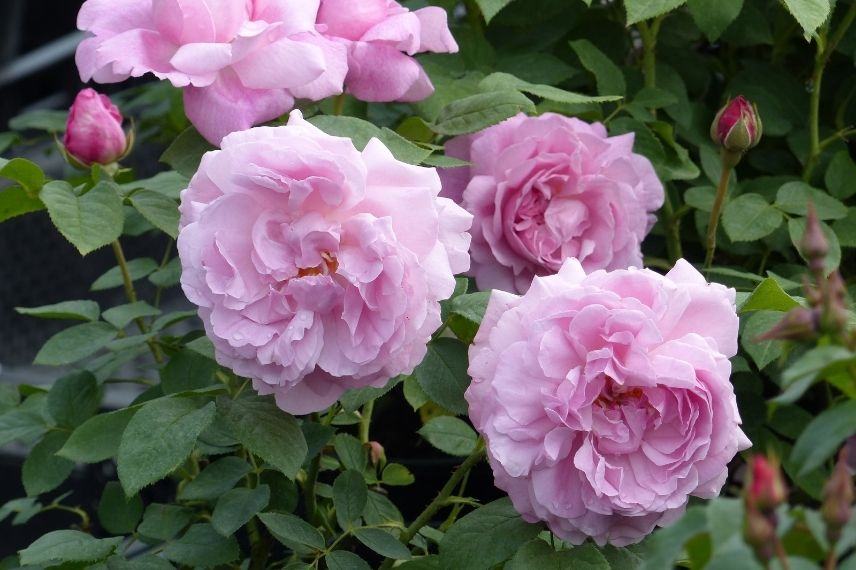
Rosa David Austin ‘Mary Rose’
The different sizes and uses of English roses
While English roses easily integrate into all types of gardens, their silhouette will depend on the chosen variety. From the smallest bush roses to the large climbing roses, each allows for different uses according to needs.
- Bush roses are perfect for beds, borders, or the front of a shrub hedge. They also lend themselves well to isolated cultivation, whether in the middle of a well-kept lawn or in a large pot to green up terraces and balconies.
Our favourite varieties barely exceed 1 metre, such as the fiery ‘Molineux’, the intense ‘Darcey Bussel’, or the gentle ‘Wildeve’. In a container, the small dimensions of ‘Hyde Park’ (85 cm high with a 75 cm spread) or ‘English Legend King Arthur’ (75 cm high with a 60 cm spread) will enhance even the smallest spaces.
‘English Legend Covent Garden’ has one of the most regular silhouettes, forming a ball of 80 cm in all directions. Even smaller, the flamboyant ‘English Legend Hamlet’ displays a low habit of only 60 to 70 cm in all directions, fitting in anywhere.
- Climbing varieties, on the other hand, are ideal for greening various structures in the garden: arbors, pergolas, gazebos, and even old trees with a somewhat sad trunk. With a sturdy support, these roses will also help conceal unsightly constructions, such as pylons, sheds, walls, or fences.
Among them, we find ‘Mortimer Sackler’, which has the advantage of being almost inermous (thornless) and can thus be grown near passageways without the risk of scratches. ‘James Galway’, ‘The Lady of the Lake’, and ‘Ozeana’ are also beautiful climbing varieties with long, flexible stems, easily exceeding 3 metres in height.
Smaller yet equally charming cultivars, reaching less than 1.5 m, can also be trained as climbers, such as ‘Graham Thomas’, ‘Spirit of Freedom’, or ‘Falstaff’.

English roses in different situations: in beds, at the foot of a tree, or climbing on a structure.
For further reading
- Discover all our tips to succeed in growing climbing roses in pots.
- Subscribe!
- Contents
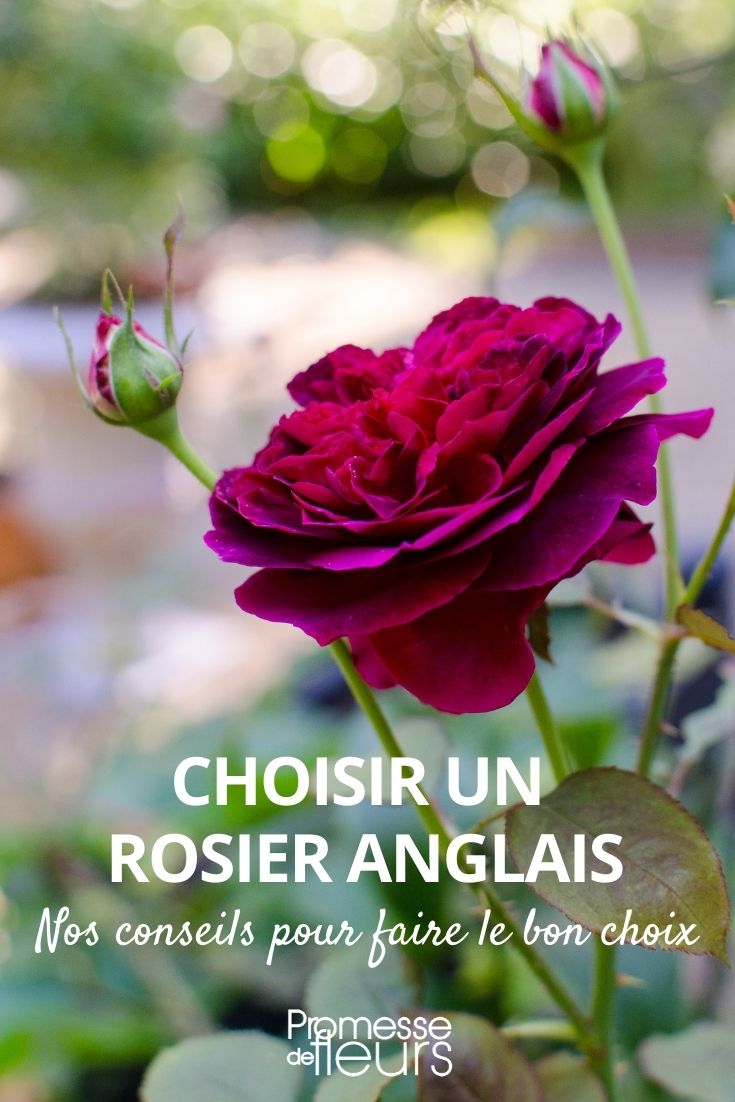































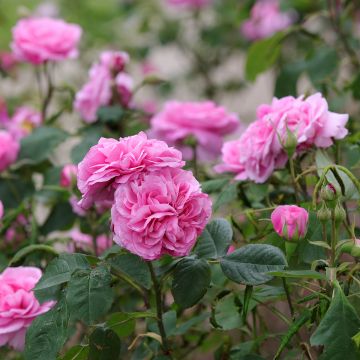
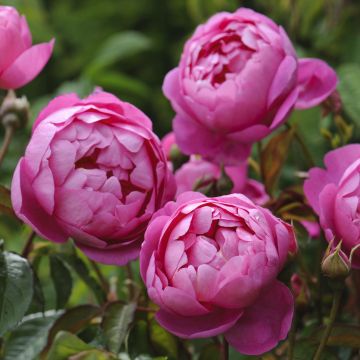
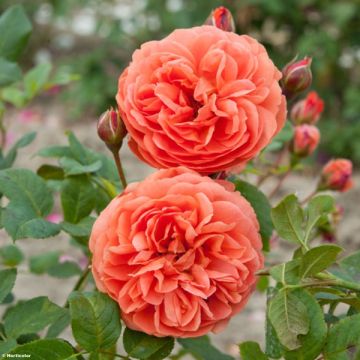
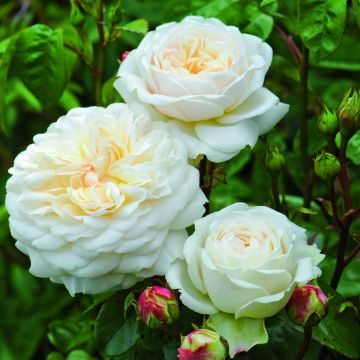
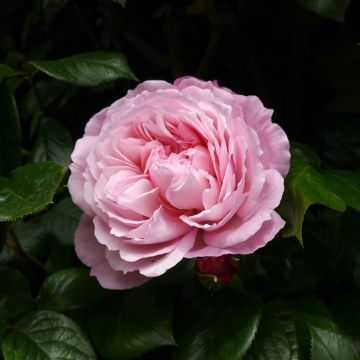
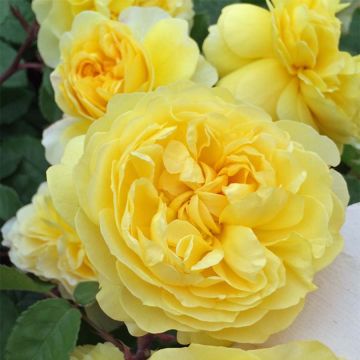
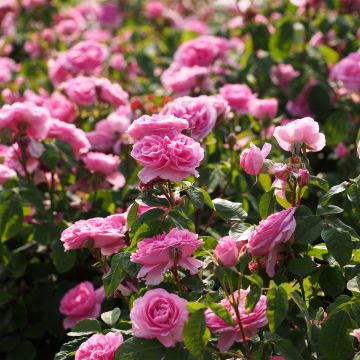
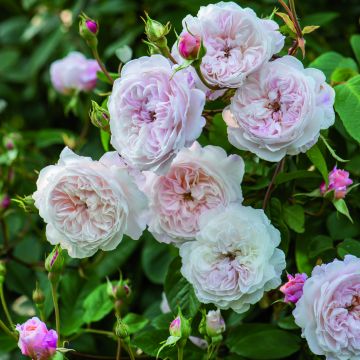
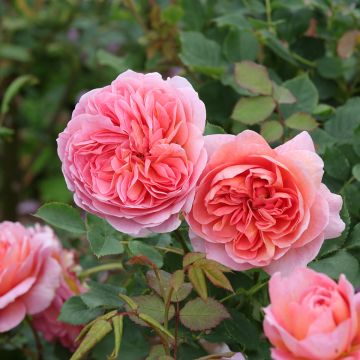
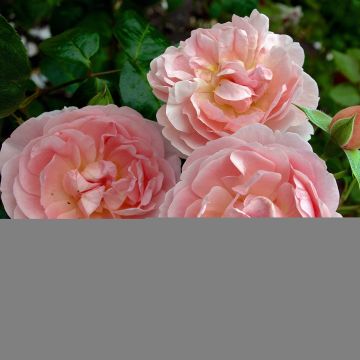
Comments